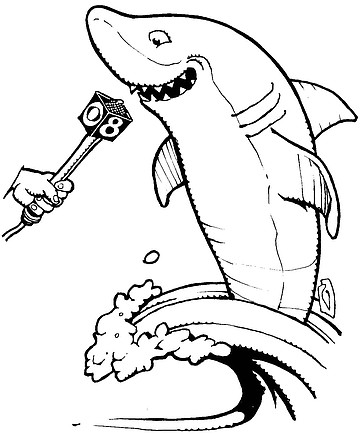 Facebook
Facebook
 X
X
 Instagram
Instagram
 TikTok
TikTok
 Youtube
Youtube

Heymatt: There must be at least 20 hours of local TV news programs M-F in San Diego and almost nothing happens here. The same non-news stories are repeated over & over mornings, afternoons, evenings and nights. Wow, a water main broke. Wow, somebody saw a shark. Wow, somebody got lost in the desert. No disrespect, but Wow, somebody committed suicide and that is breaking news for a week or two. Or months. Is this the norm for every city? I’ve checked the background of many of our newscasters and they have respectable records. But anybody and their dog could be a newscaster/reporter in this dull town. Corruption would be a hot topic but nobody seems interested in that, with a few exceptions. At least Azteca news has see-through glass tables & we can see the women’s legs. I can’t understand much Spanish but I know what I like to see. — Mungo the Perv

You’re adorable, Mungo, and you’re also easily bored, with a short attention span. Filling hours of daily local-news time does affect what a station considers “news.” First, a few generalities. According to a 2010 Pew Research survey, more than half the U.S. population relies on local newscasts as their daily news source. Second, a long time ago, yours truly was at a seminar with a local news reporter talking about his station expanding its nightly news from a half-hour to one hour. I asked him the same question you asked me. There’s not an hour’s worth of news here every day, he said, but if a station doesn’t have a one-hour newscast, it’s not “taken seriously.” All the big boys have full-hour shows. And the king of all generalities: Surveys say, local news can generate as much as 44 percent of a station’s income. All of the commercial time in that hour is bought from the local station, and the money goes to the station — not true of network programming. So how to separate all that advertising? Hmmm, where have I heard that before?
Let’s think of reporters and anchors not as newsfolk but as storytellers. That’s really what they are; it’s just that a lot of the stories they tell are pretty awful or very dull. We’ll take your example of frustration with an endless local suicide story — the woman in the Scripps mansion on Coronado, I assume. Mungo, every newshound knew that story had more legs than Dancing with the Stars. Day one we hear a woman was found hanged at the Scripps mansion owned by some big-shot rich guy. Cops are saying nothing; no visuals except the usual police tape and officers hanging around the medical examiner’s van. More! We viewers want more! Day two, chapter two of the tale. Today we find out who she is and who the big-shot is and that he’s not been seen and that his son has just died at Children’s Hospital from a mysterious fall. More! Now we must have more! Cops silent, reporters have to nose around on their own to flesh out this compelling skeleton. Day three, day four, day five — each day we get some new piece to the thriller. They are giving us “new news” each day, by any definition. We won’t be happy until the anchors all can say, “And they lived happily ever after.”
Yeah, there are times when many of us are tired of hearing about a story every night. Some of this might be because often day two of a local story consists of anchor or reporter reading a new script over yesterday’s expensively shot visuals. We’re thinking, Huh, this looks familiar. Am I bored yet? But from the newsies’ point of view, there’s a new piece to add to yesterday’s story, if only a victim’s name, so it’s still fair game for separating the commercials. Personally, if I never see another minute of the Dolly Parton Nuclear Power Plant B-roll, I’ll be just as happy. But as boring as the story looks and sounds, it’s important ongoing information for those of us downwind.
Not enough investigative stuff? There is some. It’s expensive, difficult, takes many weeks, months. And there’s always the Reader as the canary in that particular coal mine. In our effort to rake the local muck, we are now on the “don’t talk to” list of various city departments. Not that TV is wimpy. They just choose their battles carefully.
Mungo, be grateful you don’t live in one of the tinier TV markets, where competing lower-viewership stations (Fox and CW, for example) in the same city save lots of money with formal agreements that allow one reporter to shoot, write, and narrate a single story (or several stories a day!) and eventually broadcast the package on both stations. According to a recent New York Times article, 83 of the U.S.’s 210 TV markets have such contracts or complicated variants. The NYT suggests this is a creeping trend. Denver has them. Please stand. Hats off. A moment of silence for real news.


Heymatt: There must be at least 20 hours of local TV news programs M-F in San Diego and almost nothing happens here. The same non-news stories are repeated over & over mornings, afternoons, evenings and nights. Wow, a water main broke. Wow, somebody saw a shark. Wow, somebody got lost in the desert. No disrespect, but Wow, somebody committed suicide and that is breaking news for a week or two. Or months. Is this the norm for every city? I’ve checked the background of many of our newscasters and they have respectable records. But anybody and their dog could be a newscaster/reporter in this dull town. Corruption would be a hot topic but nobody seems interested in that, with a few exceptions. At least Azteca news has see-through glass tables & we can see the women’s legs. I can’t understand much Spanish but I know what I like to see. — Mungo the Perv

You’re adorable, Mungo, and you’re also easily bored, with a short attention span. Filling hours of daily local-news time does affect what a station considers “news.” First, a few generalities. According to a 2010 Pew Research survey, more than half the U.S. population relies on local newscasts as their daily news source. Second, a long time ago, yours truly was at a seminar with a local news reporter talking about his station expanding its nightly news from a half-hour to one hour. I asked him the same question you asked me. There’s not an hour’s worth of news here every day, he said, but if a station doesn’t have a one-hour newscast, it’s not “taken seriously.” All the big boys have full-hour shows. And the king of all generalities: Surveys say, local news can generate as much as 44 percent of a station’s income. All of the commercial time in that hour is bought from the local station, and the money goes to the station — not true of network programming. So how to separate all that advertising? Hmmm, where have I heard that before?
Let’s think of reporters and anchors not as newsfolk but as storytellers. That’s really what they are; it’s just that a lot of the stories they tell are pretty awful or very dull. We’ll take your example of frustration with an endless local suicide story — the woman in the Scripps mansion on Coronado, I assume. Mungo, every newshound knew that story had more legs than Dancing with the Stars. Day one we hear a woman was found hanged at the Scripps mansion owned by some big-shot rich guy. Cops are saying nothing; no visuals except the usual police tape and officers hanging around the medical examiner’s van. More! We viewers want more! Day two, chapter two of the tale. Today we find out who she is and who the big-shot is and that he’s not been seen and that his son has just died at Children’s Hospital from a mysterious fall. More! Now we must have more! Cops silent, reporters have to nose around on their own to flesh out this compelling skeleton. Day three, day four, day five — each day we get some new piece to the thriller. They are giving us “new news” each day, by any definition. We won’t be happy until the anchors all can say, “And they lived happily ever after.”
Yeah, there are times when many of us are tired of hearing about a story every night. Some of this might be because often day two of a local story consists of anchor or reporter reading a new script over yesterday’s expensively shot visuals. We’re thinking, Huh, this looks familiar. Am I bored yet? But from the newsies’ point of view, there’s a new piece to add to yesterday’s story, if only a victim’s name, so it’s still fair game for separating the commercials. Personally, if I never see another minute of the Dolly Parton Nuclear Power Plant B-roll, I’ll be just as happy. But as boring as the story looks and sounds, it’s important ongoing information for those of us downwind.
Not enough investigative stuff? There is some. It’s expensive, difficult, takes many weeks, months. And there’s always the Reader as the canary in that particular coal mine. In our effort to rake the local muck, we are now on the “don’t talk to” list of various city departments. Not that TV is wimpy. They just choose their battles carefully.
Mungo, be grateful you don’t live in one of the tinier TV markets, where competing lower-viewership stations (Fox and CW, for example) in the same city save lots of money with formal agreements that allow one reporter to shoot, write, and narrate a single story (or several stories a day!) and eventually broadcast the package on both stations. According to a recent New York Times article, 83 of the U.S.’s 210 TV markets have such contracts or complicated variants. The NYT suggests this is a creeping trend. Denver has them. Please stand. Hats off. A moment of silence for real news.
Comments